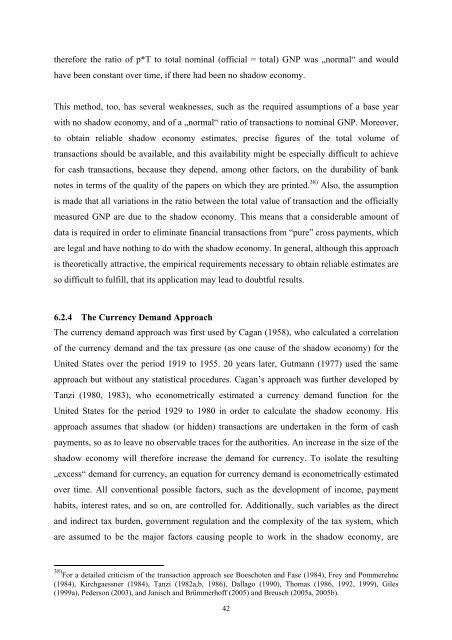Shadow Economies and Corruption All Over the World - Index of - IZA
Shadow Economies and Corruption All Over the World - Index of - IZA
Shadow Economies and Corruption All Over the World - Index of - IZA
Create successful ePaper yourself
Turn your PDF publications into a flip-book with our unique Google optimized e-Paper software.
<strong>the</strong>refore <strong>the</strong> ratio <strong>of</strong> p*T to total nominal (<strong>of</strong>ficial = total) GNP was „normal“ <strong>and</strong> would<br />
have been constant over time, if <strong>the</strong>re had been no shadow economy.<br />
This method, too, has several weaknesses, such as <strong>the</strong> required assumptions <strong>of</strong> a base year<br />
with no shadow economy, <strong>and</strong> <strong>of</strong> a „normal“ ratio <strong>of</strong> transactions to nominal GNP. Moreover,<br />
to obtain reliable shadow economy estimates, precise figures <strong>of</strong> <strong>the</strong> total volume <strong>of</strong><br />
transactions should be available, <strong>and</strong> this availability might be especially difficult to achieve<br />
for cash transactions, because <strong>the</strong>y depend, among o<strong>the</strong>r factors, on <strong>the</strong> durability <strong>of</strong> bank<br />
notes in terms <strong>of</strong> <strong>the</strong> quality <strong>of</strong> <strong>the</strong> papers on which <strong>the</strong>y are printed. 38) Also, <strong>the</strong> assumption<br />
is made that all variations in <strong>the</strong> ratio between <strong>the</strong> total value <strong>of</strong> transaction <strong>and</strong> <strong>the</strong> <strong>of</strong>ficially<br />
measured GNP are due to <strong>the</strong> shadow economy. This means that a considerable amount <strong>of</strong><br />
data is required in order to eliminate financial transactions from “pure” cross payments, which<br />
are legal <strong>and</strong> have nothing to do with <strong>the</strong> shadow economy. In general, although this approach<br />
is <strong>the</strong>oretically attractive, <strong>the</strong> empirical requirements necessary to obtain reliable estimates are<br />
so difficult to fulfill, that its application may lead to doubtful results.<br />
6.2.4 The Currency Dem<strong>and</strong> Approach<br />
The currency dem<strong>and</strong> approach was first used by Cagan (1958), who calculated a correlation<br />
<strong>of</strong> <strong>the</strong> currency dem<strong>and</strong> <strong>and</strong> <strong>the</strong> tax pressure (as one cause <strong>of</strong> <strong>the</strong> shadow economy) for <strong>the</strong><br />
United States over <strong>the</strong> period 1919 to 1955. 20 years later, Gutmann (1977) used <strong>the</strong> same<br />
approach but without any statistical procedures. Cagan’s approach was fur<strong>the</strong>r developed by<br />
Tanzi (1980, 1983), who econometrically estimated a currency dem<strong>and</strong> function for <strong>the</strong><br />
United States for <strong>the</strong> period 1929 to 1980 in order to calculate <strong>the</strong> shadow economy. His<br />
approach assumes that shadow (or hidden) transactions are undertaken in <strong>the</strong> form <strong>of</strong> cash<br />
payments, so as to leave no observable traces for <strong>the</strong> authorities. An increase in <strong>the</strong> size <strong>of</strong> <strong>the</strong><br />
shadow economy will <strong>the</strong>refore increase <strong>the</strong> dem<strong>and</strong> for currency. To isolate <strong>the</strong> resulting<br />
„excess“ dem<strong>and</strong> for currency, an equation for currency dem<strong>and</strong> is econometrically estimated<br />
over time. <strong>All</strong> conventional possible factors, such as <strong>the</strong> development <strong>of</strong> income, payment<br />
habits, interest rates, <strong>and</strong> so on, are controlled for. Additionally, such variables as <strong>the</strong> direct<br />
<strong>and</strong> indirect tax burden, government regulation <strong>and</strong> <strong>the</strong> complexity <strong>of</strong> <strong>the</strong> tax system, which<br />
are assumed to be <strong>the</strong> major factors causing people to work in <strong>the</strong> shadow economy, are<br />
38) For a detailed criticism <strong>of</strong> <strong>the</strong> transaction approach see Boeschoten <strong>and</strong> Fase (1984), Frey <strong>and</strong> Pommerehne<br />
(1984), Kirchgaessner (1984), Tanzi (1982a,b, 1986), Dallago (1990), Thomas (1986, 1992, 1999), Giles<br />
(1999a), Pederson (2003), <strong>and</strong> Janisch <strong>and</strong> Brümmerh<strong>of</strong>f (2005) <strong>and</strong> Breusch (2005a, 2005b).<br />
42
















